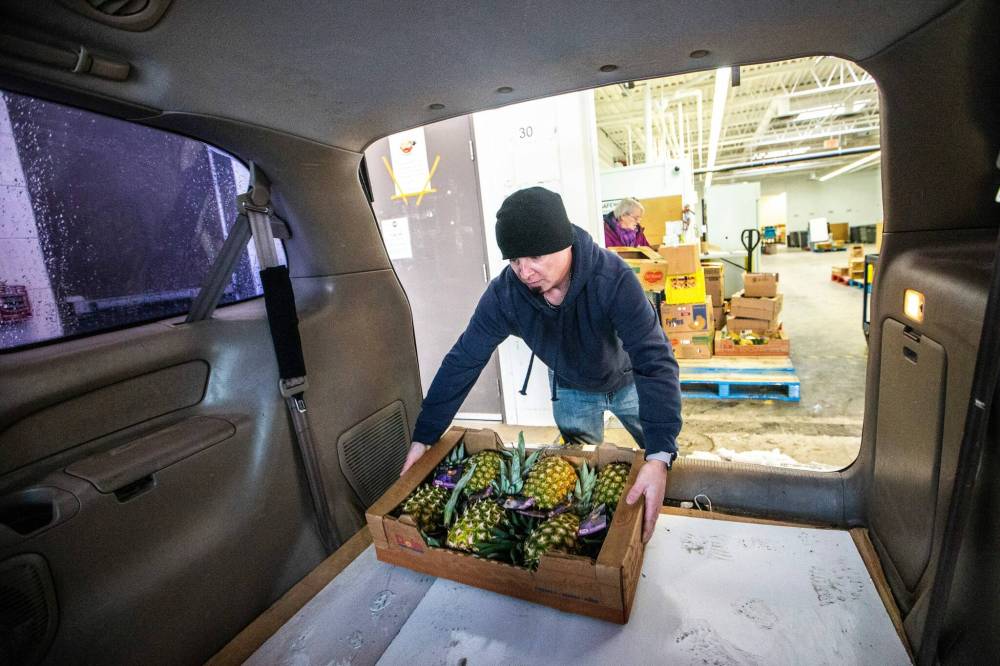Strained food banks aren’t the solution
Advertisement
Read this article for free:
or
Already have an account? Log in here »
To continue reading, please subscribe:
Monthly Digital Subscription
$0 for the first 4 weeks*
- Enjoy unlimited reading on winnipegfreepress.com
- Read the E-Edition, our digital replica newspaper
- Access News Break, our award-winning app
- Play interactive puzzles
*No charge for 4 weeks then price increases to the regular rate of $19.00 plus GST every four weeks. Offer available to new and qualified returning subscribers only. Cancel any time.
Monthly Digital Subscription
$4.75/week*
- Enjoy unlimited reading on winnipegfreepress.com
- Read the E-Edition, our digital replica newspaper
- Access News Break, our award-winning app
- Play interactive puzzles
*Billed as $19 plus GST every four weeks. Cancel any time.
To continue reading, please subscribe:
Add Free Press access to your Brandon Sun subscription for only an additional
$1 for the first 4 weeks*
*Your next subscription payment will increase by $1.00 and you will be charged $16.99 plus GST for four weeks. After four weeks, your payment will increase to $23.99 plus GST every four weeks.
Read unlimited articles for free today:
or
Already have an account? Log in here »
Hey there, time traveller!
This article was published 07/11/2023 (750 days ago), so information in it may no longer be current.
Forget sugar plums. Amid an ongoing cost-of-living crisis, many Manitobans are likely falling asleep with visions of affordable fruits and vegetables dancing in their heads.
Despite slowing month-over-month inflation rates, grocery bills remain high. While the price growth of groceries has decelerated recently, according to the latest Consumer Price Index, the cost of food has increased by nearly six per cent over last fall, when grocery prices rose at the fastest pace in 41 years.
Those stats are cold comfort to shoppers who regularly walk away from the checkout counter in a state of shock. For a growing number of Manitobans, the ramifications of sky-high grocery prices go well beyond sticker shock.

Food is a basic, biological human need but is often the first thing on the chopping block for those struggling to make ends meet. If forced to choose between paying rent or buying groceries, the former usually wins out, resulting in skipped meals, hunger pangs, nutritional deficits and, over the long term, poor health outcomes.
This is a regular cost-benefit analysis for those living below the poverty line. With persistent inflation affecting household budgets, more Manitobans are sliding into financial insecurity. That reality is evident in growing lines for local soup kitchens and recent data released by Food Banks Canada.
Since March 2022, there has been a 32 per cent increase in food bank usage across the country — representing an unprecedented 79 per cent rise over pre-pandemic levels. Food bank usage is the canary in the coal mine of poverty.
In Manitoba, one in four people who access food banks are employed, indicating a disparity between actual income and a suitable living wage. At the same time, the majority of food bank users rely on income or disability assistance, calling into question the adequacy of government social safety nets.
Harvest Manitoba, the largest local food bank, currently serves 109,000 Manitobans — 49 per cent of whom are children — per month through its provincewide network of hamper distributors, soup kitchens, daycares and school programs. That means roughly eight per cent of the province’s total population is relying on some form of donated food support in order to feed themselves and their families every single month. That’s a stark and deeply troubling problem — one that requires an urgent and multifaceted solution.
Food banks aren’t designed to tackle the deep-seated causes of poverty. And yet, these and other front-line agencies have been left bearing much of the burden of the ongoing affordability crisis.
The equation seems simple on its face: increased income plus lowered expenses equals lower rates of poverty. While government financial assistance can help lift people out of poverty — as seen with CERB amid the pandemic — lasting change also needs to include improved access to education and employment opportunities, more affordable housing stock, better mental health support and more addiction treatment services.
It’s a gargantuan task for Manitoba’s new NDP government, but one Premier Wab Kinew appears to be approaching in good faith. Last month, he established a poverty reduction committee made up of ministers responsible for a variety of files, including families, accessibility, health, housing, addictions, labour and education. While the committee’s impact is yet to be seen, the approach signals, at the very least, an understanding of the many factors that contribute to poverty in Manitoba.
Perhaps one day we will live in a society where food banks are irrelevant. Until then, communal generosity is as necessary as government action.






